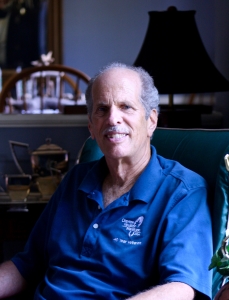By Ambassador Mariana Cano
Take a few seconds to think about these numbers: 6 minute miles, 41 consecutive Houston Marathons, 55 continuous years logging 70 to 100 miles, and several marathons completed in 3 hours or less.
All those numbers are part of the athletic life of Jack Lippincott, one of the most beloved elite runners in the Houston community, and obviously, by the Chevron Houston Marathon.
Mr. Lippincott (or Jack as he insisted I call him) is a 69-year-old runner from Indiana who moved to Houston when he was 12 years old. From an early age, Jack was very athletic and was part of the track team at Lamar High School. And while attending Rice, he ran the university trails every day.
After earning a bachelor’s in geology and working many years in the industry, he decided to start teaching science to eighth graders. It was there where, thanks to a coworker, he took interest in long runs. After completing his first marathon in 1974, he was hooked. His first Houston Marathon was the following year and he continued running it every year consecutively all while qualifying for the Boston Marathon for 30 straight years.
During his first years, Jack’s goal was discovering how fast could he run a marathon. And in 1979, after several months of hard work, he completed his fastest marathon in 2 hours, 36 minutes and 40 seconds. And I’m not exaggerating when I say hard work. He ran twice a day for weeks, which consisted of a six mile run from his house to a gym where he would shower before heading to work an eight hour shift and then he would run another 10 miles home. That’s why Jack describes himself as the King of Crazy.
Besides sharing his story with me, Jack wanted to share all his tips that have worked for him in his 50+ years of experience with all the runners participating in the Chevron Houston Marathon and Aramco Houston Half Marathon on January 17.
Here are his words:
- “Running is addictive because your brain is filled with endorphins, also because you feel an enormous satisfaction every time you get to the finish line, but you have to be very intelligent to not get lost in that feeling and to know when to stop.”
- “When you put your body in this kind of training, you simply need more minutes of sleep. For example, if you normally sleep seven hours, try to sleep 15 more minutes or half an hour more. Those extra minutes of sleep will really make a difference because your body needs to rest in order to recover and prevent an injury or a collapse.”
- “It’s very important that you are flexible with your training. You have to be reasonable. Your free days could vary depending on several factors like tiredness, a night out, or simply because you had a bad day. Don’t stress out if your week’s training changes. If you had an easy week, you can make the next one a hard week and if you had an easy day, make the next one a hard one.”
- Jack believes that running is not for everybody. “Each person is different, if it doesn’t make you feel good, don’t continue doing it.”
- “When training for a marathon, the long runs shouldn’t exceed 18 or 20 miles and your pace should be way slower than on race day.”
- “During the marathon try not to go faster than you have to, otherwise you risk facing the 20th-mile-wall. I recommend you to participate in several races previous to the marathon like the warm-up series so you can discover what your ideal pace is and you can stick to it during the race.”
- “If you face the 20th-mile-wall, do the “Gallowing” – the Jeff Galloway method that consists in doing intervals of running-walking-running. Don’t think that walking is going to slow you down, a lot of times, it works better that trying to keep running.”
- “A great way to keep your pace during the race, is to follow the Pace Leaders. They are legacy volunteer runners that guide runners during a race with a flag that shows the time in which they’ll finish the race. I was a Pace Leader a couple of times and the hardest part was slowing down runners especially in the first three miles. When you hear the starting pistol at the starting line, the adrenaline rush is so big that you tend to run faster, but if you overdo it, you’ll pay for it in mile 18. So better follow your Pace Leader!”
As you can tell my chat with him was extremely interesting. I will be forever grateful for all the tips and advice, which have definitely changed the focus of my training, and I’ll try to follow them strictly so I can have a good and fulfilling race.
Mr. Lippincott … I mean Jack, let me tell you that I totally agree with you and you are definitely the King of all the crazy runners in the world, but you are also King of a club that besides craziness, has perseverance, tenacity, courage and discipline; a club that I’m glad to be part of.
Yo Mariana will be there rooting for you when you complete your next two goals: finishing the Houston Marathon on January 17th in less than five hours and running the 2017 Marathon that will be your first race after turning 70.
I also want to thank all the veteran runners that do the valuable task of being Pace Leaders at the event. You make a huge difference and help us runners a lot during the course. Thanks you!
To everyone doing a race in the near future, I wish you the best of lucks. Follow these tips and you’ll see that everything will be easier.
About the Author: Mariana Cano
Mariana has run four half marathons and one marathon. She’s a mom who started running when her first daughter was born to lose the baby weight and fell in love with it! Up to this day, Mariana finds it very hard to wrap her head around the idea of how her body can physically resist running non-stop for two hours or more, but after 10 years of running she just keeps going. Mariana is a Mexican mom of three children under 10, who has been living in Houston sine 2004.
Blog – www.yomariana.com
Twitter – @yomarianablog
Instagram – @yomarianablog


